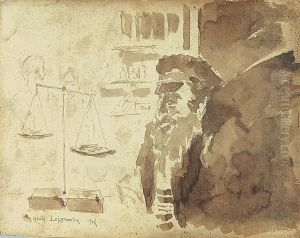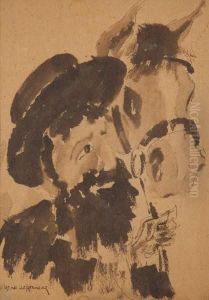Izrael Leizerowicz Paintings
Izrael Leizerowicz was a Polish-Jewish painter, born in Łódź, Poland in 1907. His life and career were dramatically affected by the historical events of the 20th century, particularly the Holocaust. Growing up in a vibrant cultural environment, Leizerowicz developed an early interest in art, which was nurtured by the lively artistic scene in Łódź, a city known for its industrial prowess and its diverse population of Poles, Jews, Germans, and Russians. This multicultural backdrop influenced his artistic vision and the subjects of his works, which often depicted scenes of everyday life, Jewish traditions, and the human condition.
His artistic education was undertaken at the School of Fine Arts in Warsaw, where he honed his skills in painting and drawing. Leizerowicz's work from this period shows a keen understanding of European art movements, blending elements of Expressionism and Realism to create compelling portraits and landscapes that reflected the complexities of interwar Poland. Despite the growing tensions and the rise of anti-Semitism in Europe, he remained active in the artistic community, participating in exhibitions and gaining recognition for his unique style and perspective.
However, Leizerowicz's promising career was cut short by the outbreak of World War II and the subsequent Nazi occupation of Poland. In 1939, he was confined to the Łódź Ghetto, where he continued to create art under harrowing conditions. His works from this period offer a haunting glimpse into the lives of the ghetto's inhabitants, capturing their despair, resilience, and humanity amidst the atrocities. Leizerowicz's art became a form of resistance, documenting the reality of life in the ghetto and the indomitable spirit of its people.
Tragically, Izrael Leizerowicz's life and artistic career were ended when he was murdered in the Holocaust in 1944. Despite the brevity of his career, his artworks serve as a powerful testament to the resilience of the human spirit in the face of unimaginable cruelty. Leizerowicz's legacy lives on through his surviving works, which are preserved in various collections and museums, serving as a poignant reminder of the vibrant cultural life that was destroyed during the Holocaust and the enduring power of art to bear witness to history.

